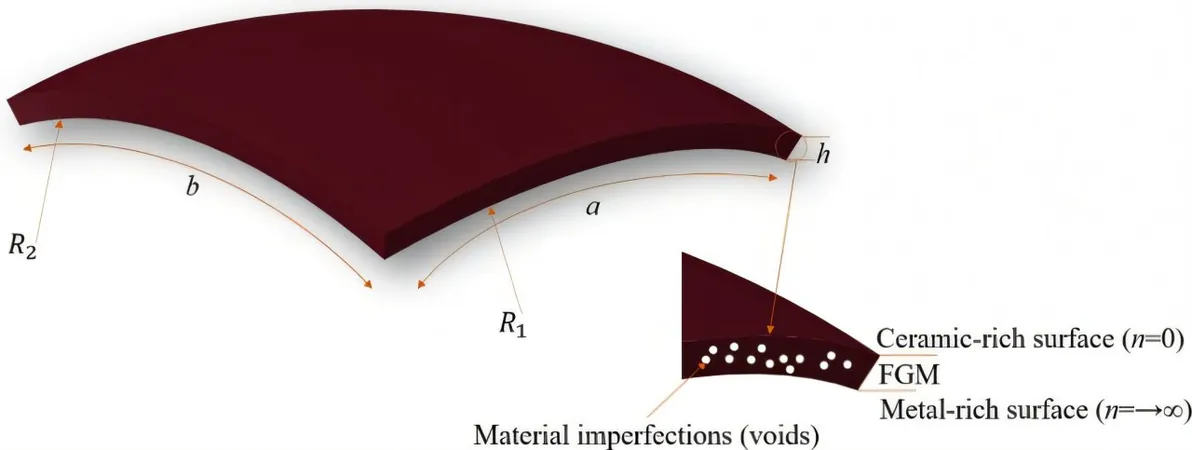
Unleashing the Power of Microshells: A Revolutionary Breakthrough in Tiny Tech Vibrations!
2025-01-02
Author: Sarah
Introduction
In the realm of modern engineering, Functionally Graded Materials (FGMs) have emerged as groundbreaking innovations. These materials exhibit a gradual variation in properties, providing impressive resistance to thermal and mechanical stresses. However, a significant challenge lies at the microscale—tiny voids or porosity can compromise their structural integrity and vibrational dynamics.
The Research Study
Traditional analytical models largely fail to accurately predict the complex behaviors of these microscaled structures, leading to a pressing demand for sophisticated frameworks. Recognizing this gap, an enterprising team of researchers from the University of Adelaide, the University of Canberra, and Westlake University embarked on an ambitious study that was published on December 9, 2024, in the prestigious International Journal of Mechanical System Dynamics. This pivotal research delves into the vibrational behavior of FGM microshells, meticulously dissecting how factors like material composition, imperfections, and microscale coefficients impact their vibrational frequencies.
Innovative Approach
In a groundbreaking approach, the team utilized a cutting-edge five-parameter shear deformable model to explore the free vibrations of doubly curved imperfect FGM microshells. They introduced an innovative modified power-law rule to effectively capture the uneven logarithmic distribution of porosity throughout the microshell's thickness, addressing the critical issue of material imperfections. Utilizing Hamilton's principle, they derived precise equations of motion for these sophisticated structures, significantly advancing the analytical capabilities in this field.
Significance of Findings
Dr. Behrouz Karami, the lead researcher, emphasized the importance of these findings: “Our research unravels the intricate interplay between material composition, porosity, and microscale effects on the dynamics of FGM microshells. This understanding is pivotal for developing high-performance microsystems, particularly in fields like micro-electromechanical systems (MEMS) and biomaterials, where precise material properties are non-negotiable.”
Implications for Engineering
The implications of their research are vast and significant. By honing in on the vibrational properties of these microshell structures, engineers stand poised to design advanced MEMS devices and biomaterials that are not only lighter and stronger, but also exhibit enhanced resilience under real-world conditions. This progressive knowledge could catalyze innovations across various critical sectors, such as automotive engineering and medical technology, where the need for high-performance and lightweight components is paramount for optimizing efficiency and ensuring safety.
Conclusion
As we stand on the verge of a new era in microsystem design, the research on the vibrational characteristics of FGM microshells may very well be the key to unlocking the next generation of technological marvels!





 Brasil (PT)
Brasil (PT)
 Canada (EN)
Canada (EN)
 Chile (ES)
Chile (ES)
 Česko (CS)
Česko (CS)
 대한민국 (KO)
대한민국 (KO)
 España (ES)
España (ES)
 France (FR)
France (FR)
 Hong Kong (EN)
Hong Kong (EN)
 Italia (IT)
Italia (IT)
 日本 (JA)
日本 (JA)
 Magyarország (HU)
Magyarország (HU)
 Norge (NO)
Norge (NO)
 Polska (PL)
Polska (PL)
 Schweiz (DE)
Schweiz (DE)
 Singapore (EN)
Singapore (EN)
 Sverige (SV)
Sverige (SV)
 Suomi (FI)
Suomi (FI)
 Türkiye (TR)
Türkiye (TR)
 الإمارات العربية المتحدة (AR)
الإمارات العربية المتحدة (AR)